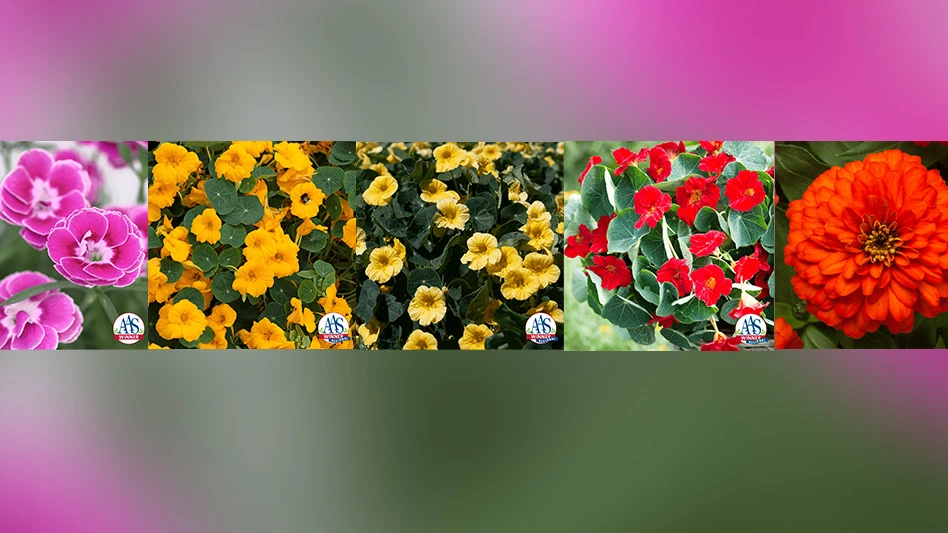

Greenhouse Management: What are some of the fungal foliar leaf spots growers should watch for?
Nancy Rechcigl: Every plant species is prone to different leaf-spotting pathogens, so it is important to become familiar with the ones that could potentially affect your crops, such as:
- Alternaria spp.: Aquilegia, Calendula, Coreopsis, Dianthus, Geranium, Impatiens, Marigold, Pansy, Shasta Daisy, Stock, Vinca, Zinnia
- Cercospora spp.: Coreopsis, Hydrangea, Liatris, Monarda, Pansy, Phlox, Rudbeckia, Snapdragon, Zinnia
- Anthracnose/Colletotrichum: Daylily, Gomphrena, Heuchera, Hosta, Lupine, Snapdragon, Stokesia
- Corynespora spp.: Crossandra, Foxglove, Hydrangea, Ornamental Pepper, Sage/Salvia
- Myrothecium spp.: Ajuga, Begonia, Echinaceae, Gerbera Daisy, Lantana, Salvia, Stock, Verbena
- Septoria spp.: Gaillardia, Shasta Daisy, Phlox

GM: What are some conditions that leaf spots tend to favor? How can those conditions be avoided?
NR: This time of year, leaf spots can be particularly challenging for greenhouse ornamentals since nightly dew provides perfect conditions for spore germination and infection. Leaf spot development favors conditions such as wet foliage, high humidity and poor air movement. Cultural practices such as reducing leaf wetness and spacing plants for increased air flow are important for prevention, as well as proper sanitation practices.
GM: What symptoms should growers scout for?
NR: When scouting for leaf spots, inspect foliage in the lower and interior canopy of the plant, as they may initially develop there due to reduced air movement and higher relative humidity. They can vary in shape and size, depending on the pathogen, but tend to look more rounded and have distinct margins with a colored border. Under certain environmental conditions, some may form small black fruiting structures within the leaf spot.
GM: Why is product rotation so important in preventing foliar leaf spots?
NR: Fungicide resistance can occur quicker in pathogens that produce a lot of spores, like foliar leaf spots. To avoid resistance, include at least two to three products with different modes of action in a rotation program. Programs should incorporate a combination of products with systemic and contact or translaminar activity that maximizes their strengths and leverages modes of action when they are most beneficial.
GM: What solutions does Syngenta offer to help growers prevent leaf spot diseases?
NR: Our greenhouse program for leaf spot prevention includes a rotation of Daconil WeatherStik® or Daconil Ultrex® fungicides applied early in production followed by Palladium® and Mural® fungicide sprays applied on a 14-day interval. For active infections, apply products on a 7-day interval.
Palladium is a combination of two active ingredients, fludioxonil (FRAC 12) and cyprodinil (FRAC 9), for systemic and contact activity on leaf spot pathogens. Mural contains benzovindiflupyr (FRAC 7), one of the most broad-spectrum SDHI fungicides, combined with a reliable industry standard, azoxystrobin (FRAC 11), for control of a wide range of foliar and root pathogens.

Do you know someone that has made a positive impact in the horticulture industry? Nominate them for a Horticultural Industries Leadership Award (HILA)!
| SUBMIT NOMINATION |

Explore the May 2020 Issue
Check out more from this issue and find your next story to read.
Latest from Greenhouse Management
- Meet the Next Gen: Gabriella Blair, Star Roses and Plants
- Leading Women of Horticulture: Katie Dubow, Garden Media Group, and Aubry Field, Lizzy Blossom
- Showing up at your horticulture business as your whole self
- Leading women of Greenhouse Management
- USDA fires experts on invasive pests, including Asian citrus psyllid, chilli thrips
- Farwest Show calls for 2025 New Varieties Showcase entries
- Leading Women of Horticulture: Arden Pontasch, North Creek Nurseries
- Leading Women of Horticulture: Emily Showalter, Willoway Nurseries








